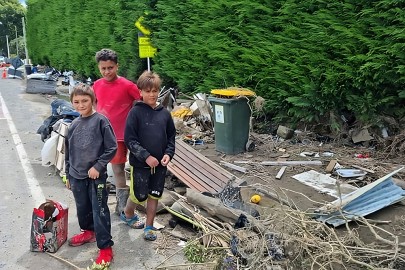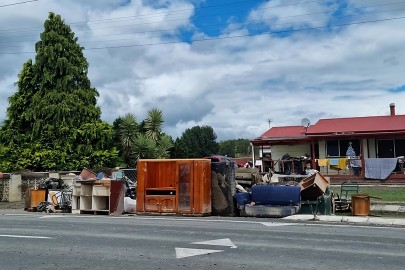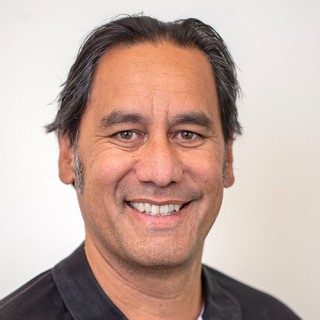
Young people helping move damaged property to the roadside ready for pickup by the Army in Omāhu.
A recent Ngā Pae o te Māramatanga New Zealand’s Māori Centre of Research Excellence wānanga explored this question by sharing whakaaro from Māori community leaders affected by Cyclone Gabrielle in February.
Facilitated by Manaaki Whenua Kaihautū Māori Research Impact Leader Dr Shaun Awatere (Ngāti Porou), the online wānanga shared the challenges faced by Tairāwhiti (Gisborne), Heretaunga (Upper Hutt) and Te Tai Tokerau (Northland) leaders and what they need for recovery and future resilience after recent devastating events.
Shaun says it was evident from the kōrero that many whānau had suffered significant trauma because of the cyclone and continued flooding in 2023. “With many marae, urupā (burial grounds), kohanga reo and community facilities damaged or destroyed, we heard about the significant loss of cultural health for many whānau – not to mention the hundreds of whānau displaced from their homes.”
Shaun also noted a theme from leaders who were frustrated by the lack of local and central government support – or lack of consultation with iwi and whānau.
“There is a sense of distrust from some communities who do not believe these institutions can help them and want the right to assert their own tino rangatiratanga (self-determination) through the recovery process.”
A community who has done just that is the Piringa hapū of Omāhu just north of Hastings in Hawke’s Bay.

Flood-damaged property piled up on the streets of Omāhu in Hawke’s Bay.
Omāhu Marae chairperson Meihana Watson spoke of the significant devastation caused by the cyclone in his community: 153 homes damaged or destroyed, and 30% of these were either uninsured or underinsured.
There was also damage to urupā, churches, marae, kohanga reo, pā sites and other sites of cultural significance.
The community struggled with a lack of support from local council and other agencies, Meihana told the wānanga. “As a community we are used to being resilient, so we stood up in those first few days.”
Omāhu Marae was cleared and a welfare hub was established for whānau, and there have been an average of 45 whānau staying at the marae since then.
It was also not long before the hapū established Utaina – a 10-year recovery plan, which was drafted in March and endorsed by April. Meihana describes this plan as hapu-led and Crown and iwi enabled, seeing the hapū recognise their tino rangatiratanga.
“Nothing about us without us,” says Meihana.
The hapū has worked hard since then to source 18 self-contained cabins for displaced whānau and they are working to expedite the progress of shifting yellow-stickered houses to white-sticker status.
Similarly, Willie Te Aho from Toitu Tairawhiti Housing Limited has been instrumental in supporting whānau from Te Karaka, inland from Gisborne, with their recovery efforts.
Toitu Tairawhiti has provided a number of temporary houses for whānau displaced by the cyclone and have offered support around insurance claims for those displaced. They are also working to repair damaged homes and aim to have whānau back in their community by the end of August.
“It is going to be a long road to recovery,” Willie told the wānanga.
“We have faced similar challenges to Omāhu in terms of council support as well as gaining access to the data we need.”
Shaun says this whakaaro highlights the need to frame extreme weather responses for Māori.
“We need to frame responses from the needs of the whānau in the area rather than a universal approach – the opportunity to exercise tino rangatiratanga is what Māori need.”

